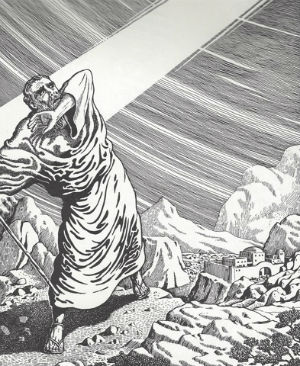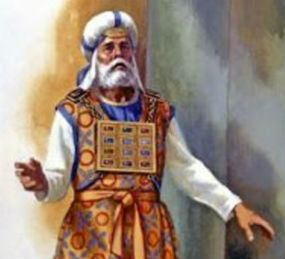Hebrews 11 – Our Journey to God’s Restland
By Neil Earle
In our survey of the Letter to the Hebrews we have reached the exquisite chapter 11 which is so well-known to Christians yet also a summary of the writer’s entire argument so far.
Remember, Hebrews 1:1-2 began with God making the world through Jesus Christ (John 1:1-2) and here in 11:1-3 we are told that the universe was created out of “things invisible.” That is true whether you refer to the Great and Invisible God or to what scientists would focus on – the invisible but powerful world of the atom.
For years I taught teens that “they did so believe in things they can’t see.” The atom and its multitudinous particles are not visible to the naked eye and yet the atom and its accoutrements lie close to the heart of all matter that exists.
The Greeks believed in a universe that always existed out of “necessity.” Sort of a dark depressing opener. Yet here is the letter to the Hebrews affirming a personal origin in time and space by a Being outside them both, a Super-Intelligence who not only creates but upholds the cosmos by his word of power (Colossians 1:16-17).
“Father of the Faithful”
Hebrews 11 focuses a lot on Abraham as the father of the Christian faithful, a man called to set out “not knowing where he was going.” The Christian too must ultimately follow God on faith i.e. the spiritual evidence in his mind and spirit of things unseen. It is by faith that we apprehend that the saving work done by Jesus on the cross 2000 years ago now applies to us. We are forgiven through the righteous act of Christ but that certainty, that conviction of our salvation comes to us by faith, which is a gift of the Spirit of God (Galatians 5:22).
Hebrews 11:9 mentions Abraham and his family as sojourners, spiritual travelers on the road to an ultimately eternal city God is preparing (11:10). They didn’t see that final city but they were convinced of it and as a result had many sub-promises fulfilled along the way. So do we, and this encourages us to “trust and obey” as the hymn says.
 God speaks to Abram, telling him to leave Haran and go to the land of Canaan. (Basil Wolverton artwork)
God speaks to Abram, telling him to leave Haran and go to the land of Canaan. (Basil Wolverton artwork)Mediator of the Old Covenant
Moses comes in in Hebrews 11:23 – Moses who built the tabernacle of God but was also prophet of a greater Prophet than himself (Deuteronomy 18:15). Hebrews 3:1-5 said already that Moses was faithful in God’s house but Jesus – as Creator – was greater in that he built the house. The whole purpose of the Hebrews letter was to show the superiority of the Christian revelation to what the people were given under Moses, to which some were tempted to return.
The Old Covenant had beautiful and meaningful rituals. It was glorious (2 Corinthians 3:11) but was only meant to point to Christ, the true Tabernacle, the real High Priest in heaven. Yet somehow those Hebrews were under pressure to return to a form of Judaism, perhaps under the stress of the Jew-Roman tension that historians tell us was building in Jerusalem in the 60s AD. James the Just (as the Jews called him), the brother of Jesus, was thrown from the temple pinnacle by jealous priests during the time between the arrival of two Roman governors in 62 AD. This may be the serious background to the Letter and the need for the writer to give strong inducements to his hearers to carry on, persevere and not stop meeting together (Hebrews 10:23).
A Heavenly Country
The fact that the old covenant people were headed for a “heavenly country” identifies their struggle with our own (11:13-14). Still they did not have the privileged information we have. We are told that we are headed for an eternal rest in the heavenly places in Hebrews 13:18-24. Mt. Sinai and the enunciation of the old covenant were spectacular, but the journey to the spiritual mountain Mt Zion is infinitely more wonderful.
We know from Revelation 6:9-11 that harassed Christians on earth are given white robes symbolic of their heavenly rest at the end of their lives. Though their spirit returns with Jesus at his coming (as told in 1 Thessalonians 4:13), this reuniting with those who have gone before our writer describes as a marvelous graduation ceremony. The righteous dead are asleep to all intents and purposes – “sleeping in Jesus” – but their spirits are ushered into God’s eternal presence (Philippians 1:23) and given access to “the spirits of just man made perfect” (Hebrews 11:23). The great Bible teacher John Owen tells us, “Spirits are that essential part of our nature that subsists in a separate state from the body.”
This temporary separation of soul and body explains how we are able to enter the heavenly realms (Ephesians 2:6) apart from our bodies which rest in the grave to be reunited with our spirits at the resurrection of the just (1 Corinthians 15:42-44). Marvelous this, all part of the rewards for the well-lived life of faith that extends beyond this physical existence.
Abraham, Moses, all the heroes of Hebrews 11 are right now in the heavenly places along with the faithful Christian dead who have gone on before. Or so most commentators feel.
All of this makes up part of the great hope of the Christian life, the end result of our faith, a faith which works for us in the here and now as well as the future. For the mouth of the Lord has spoken it.
Meaning of the High Priestly Garments
 The high priest points to our living high priest, Jesus.
The high priest points to our living high priest, Jesus.Romans 15:4 tells us all that things written in the Old Testament were for our benefit in the new covenant church. The ceremonies of the past pointed to Christ and his eternal High Priestly ministry for us as our Intercessor, Mediator and Defense Attorney in heaven (Hebrews 6:20; 1 John 2:1).
The garments begin with the long white robe underneath that depicts the righteousness of God, his purity and perfection. But since no one can look on God in his perfected state and live, the robe is covered with another garment all of blue, blue which depicts the grace of God whereby we are reminded that we approach him through grace and mercy, a mercy towards us truly higher than the heavens (Psalm 103).
Next comes the linen “ephod” or tunic as we would say today. The ephod is embroidered with earth colors depicting Jesus as perfect man, of the earth earthy as our Mediator between heaven and earth. The girdle around the ephod symbolizes the Holy Spirit as holding all things together in the unity of the Spirit. On the ephod is the breastplate which has the named of the twelve tribes of Israel, depicting God carrying his people close to their heart. There is an old hymn, “When he cometh, when he cometh, to make up his jewels” from Malachi 4 that depicts this theme.
The turban has the words “Holiness to the Lord” inscribed on its crown and since this is the first thing people see when they meet the high priest then it reminds us of our calling to represent the Lord. The color scheme throughout is made up of gold (divine) blue (heavenly) and purple (kingly) aspects of Jesus our Lord. The whole system was holy and designed to last "forever" – "olam” in the Hebrew, depicting “as long as the circumstances exist.” But since the old covenant is now superseded as Hebrews 8:13 shows, we are invited to depict the spiritual lessons form this system to learnt hat it all points to Jesus, the Author and Finisher of our Salvation (Luke 24:27).